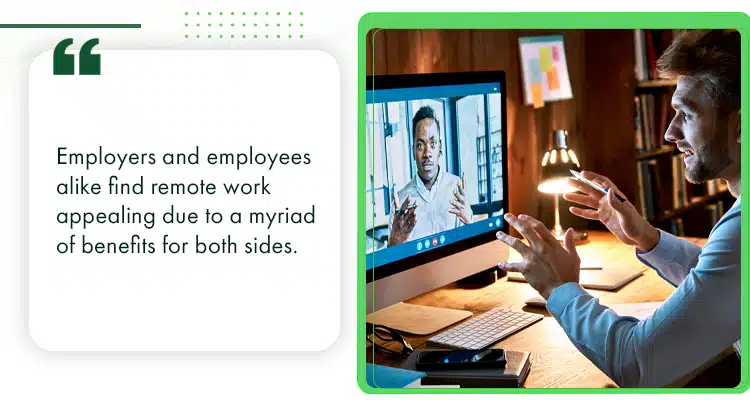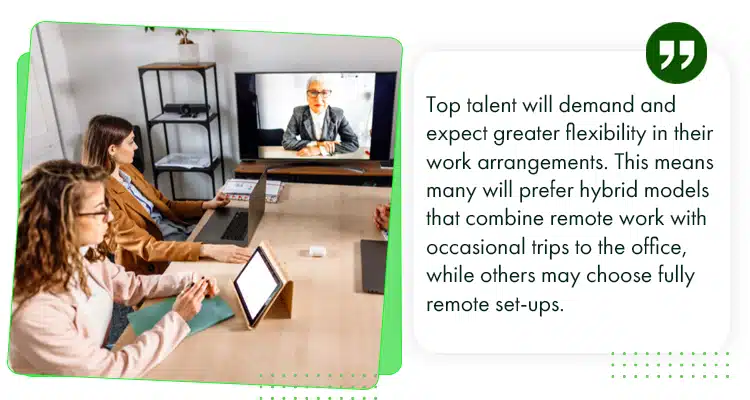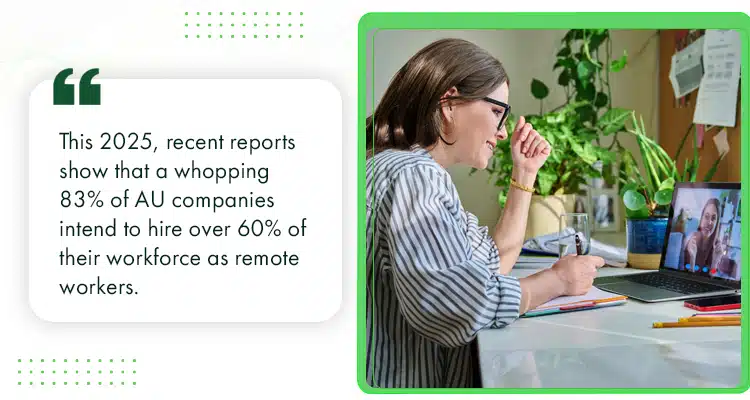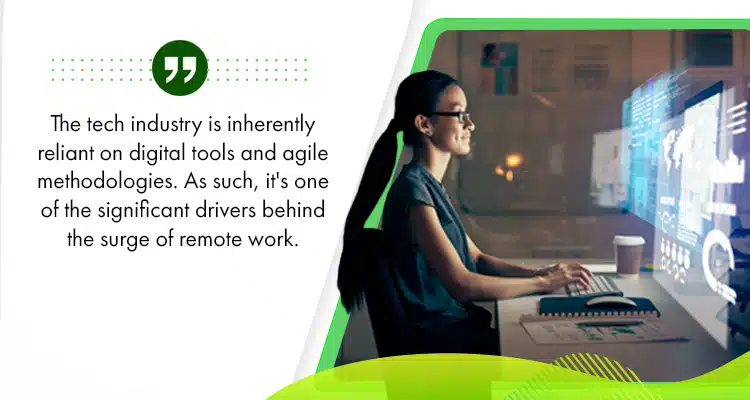Everyone knows remote work became mainstream during the COVID-19 pandemic in 2020. That’s pretty much passe at this point.
However, as the world recovered, many businesses issued return to office (RTO) memos. This sparked mixed reactions—some pushed for hybrid setups, while others resigned to seek full-time remote work.
But this didn’t stop most companies from enforcing RTOs—except in Australia. In fact, many Australian businesses prefer hiring remote workers this 2025 instead of requiring them to report onsite.
So, why do AU companies prefer remote hiring? What motivates this choice and how does it benefit their businesses? Can doing the same thing benefit YOURS? How?
Read on to know more.
How Remote Work is Redefining Hiring in Australia
Remote work has allowed AU businesses to expand their talent pools beyond their geographical location. As a result, Aussie employers adapted their hiring strategies and focused on skills and cultural fit instead of proximity.
Statistical Trends in Australian Remote Work
In 2023, 37%, or 4 out of 10 Australians, worked from home at least once a week. This was a significant increase from the 13% pre-pandemic. In addition, 45% of Australian workers have a hybrid arrangement, working in the office for a few days and remotely for the rest of the week.
Meanwhile, in 2024, remote work continued to grow in popularity across most Australian companies. Data shows that 97% of organizations offered some form of a flexible remote setup – with 62% doing so to attract and retain staff.
Why Remote Work Is More Than a Passing Trend for 2025
This 2025, recent reports show that a whopping 83% of AU companies intend to hire over 60% of their workforce as remote workers.
The same study also showed that Australia is one of the leaders in hiring remote employees, followed by Japan, South Korea, and India.
Here’s why:
- Employee Demand – Most employees now prefer remote work, so businesses are adapting to attract skilled talent who value flexibility.
- Cost Savings – Remote work offers substantial cost-saving benefits for businesses, including reduced office space requirements and lower overhead expenses.
- Talent Acquisition – It also allows companies to access a vastly expanded talent pool, enhancing recruitment efforts and preventing skill shortages.
Case Studies: Australian Companies Successfully Embracing Remote Work
If you’re wondering whether your company can go fully remote, it’s helpful to look at companies that have already made the shift.
Fortunately, this is easier if you’re an Australian firm, as many of their contemporaries have successfully embraced remote work and are thriving as a result:
#1. Canva
Canva has a remote-first model that has been instrumental in attracting top-tier talents. As of May 2024, Canva was valued around $26 billion, equivalent to AUD $41.9 billion, with 185 million active users worldwide.
The graphic design platform has a diverse pool of skilled designers, developers, and professionals from across the globe, fueling the company’s rapid growth and innovation.
Hiring Practices and Employee Retention Strategies
Canva prioritises talents that align with their values of creativity, collaboration, and user-centric approaches.
As such, they hire for skills and potential, recognising that individuals can be upskilled and trained within the company. Moreover, their remote-first approach allows them to access global talent, attracting skilled designers and developers from diverse backgrounds and locations.
In addition, Canva invests heavily in employee growth and development. They foster a strong company culture through virtual events, team-buildings, and transparent communication channels.
More importantly, they offer flexible work arrangements, empowering employees with autonomy over their work schedules, often resulting in better output.
#2. Atlassian
Meanwhile, AU software company Atlassian has a “Team Anywhere” strategy, allowing employees to work from anywhere, as the company values results over traditional measures like presenteeism.
This trust-based approach fosters autonomy especially in the tech industry, allowing employees to work in ways that best suit their individual needs and work styles. This strategy clearly works for the company as it recorded a whopping $4.3 billion dollars in revenue, or roughly about AUD $6.9 billion in 2024.
Hiring Practices and Employee Retention Strategies
As a software company, Atlassian uses its own products to facilitate seamless collaboration among remote teams.
They also recognise the importance of expanding their hiring strategies beyond traditional geographical limitations, especially if they want to find skilled developers. This led to increased diversity within the workforce, resulting in a wider range of perspectives and experiences.
Additionally, Atlassian understands the importance of employee well-being in a remote work environment. Thus, they offer flexible work arrangements, generous parental leave policies, and even support for mental health and well-being initiatives.
#3. Culture Amp
Employee engagement platform, Culture Amp, also exemplifies a company that has thrived with a remote-first approach.
As a company that provides employee engagement solutions, it deeply understands the importance of a positive employee experience. Their remote-first model allows them to “live the product” by firsthand experiencing the challenges and benefits of a distributed workforce.
Its innovative and flexible approach has resulted in Culture Amp becoming a $2 billion powerhouse, making it the largest culture analytics firm in the world.
Hiring Practices and Employee Retention Strategies
Culture Amp has cultivated a strong and vibrant company culture. They conduct regular virtual team-building activities, focus on shared values and goals, and prioritise transparent communication.
They also actively work to create an inclusive and equitable remote work environment for all employees, regardless of location or background.
For instance, they provide access to resources and support for employees in different time zones, ensuring all voices are heard and valued.
Furthermore, Culture Amp uses its own platform to gather employee feedback and gain insights into the effectiveness of its remote work policies and practices. This data-driven approach allows them to continuously improve their remote work model, ensuring a positive employee experience.
Remote Work Trends in Australia: A Data-Driven Overview
Australia has embraced remote work, particularly in the technology, finance, and education sectors:
Tech Industry
The tech industry is inherently reliant on digital tools and agile methodologies. As such, it’s one of the significant drivers behind the surge of remote work.
Moreover, its innovative and flexible nature has readily embraced remote work, inspiring other industries to follow suit, if their work model allows it. In addition, cloud computing, robust communication platforms, and collaborative tools also helped distributed teams work together.
As remote work continues to dominate the tech industry, AU companies operating within IT consulting, software development, and cybersecurity are recognising the strategic advantages of offering remote positions.
By removing geographical constraints, they’re able to attract skilled professionals from different AU cities and even internationally.
Finance Industry
The Australian finance sector has also steadily embraced remote work for a growing number of roles, such as financial analysis, data entry, and customer service.
As finance shifts from traditional banking to fintech, more and more financial institutions recognise the value of remote work.
For instance, fintech companies are known for their agile and often “remote-first” cultures, characterised by innovative approaches that combine finance and technology to deliver fast solutions to clients.
Thus, the nature of their work enables remote arrangements, allowing them to hire skilled bankers and finance experts worldwide, fostering a more diverse and competitive workforce.
Education
Remote arrangements have also changed the course of Australia’s education sector. The emergence of online learning platforms and sophisticated remote teaching tools have greatly changed how education is delivered.
This enabled educators to reach students across different locations, enhancing accessibility to education. It also fostered greater flexibility for both educators and students.
This is particularly important as Australia is considered a leading destination for international students. However, the country is also facing a shortage of teachers, hence the need to hire foreign educators to keep up with the growing demands.
Advantages of Remote Work for Both Employers and Employees
Employers and employees alike find remote work appealing due to a myriad of benefits for both sides.
Benefits for Employers
Australian employers are recognising the advantages of ditching traditional offices in favor of remote work for the following reasons:
- Access to Diverse Talent Pools – Employers are no longer confined to hiring locally. With remote work, they can attract skilled professionals with relevant experience, regardless of the location.
This expanded reach allows employers to find the most qualified candidates available, not just those in the immediate vicinity. This enhances the quality of the workforce and at the same time, gives the company diverse perspectives and insights. - Cost Reduction in Office Expenses – Maintaining an office can be expensive with all the rent, electricity, and other overhead expenses, especially now that AU is facing rising rent charges.

- Increased Productivity and Employee Satisfaction – Studies show that workplace stress can result in burnout, low morale, and high absenteeism. Moreover, research supports that employee-commuters tend to experience higher psychological stress compared to remote workers.
Thus, by providing employees with the flexibility to work from a location of their choosing, companies are better-positioned to maximise their productivity. The flexibility also allows employees to work during their most productive hours, minimise distractions, and achieve a healthier work-life balance – which leads to better results and lower turnover for their employers as well.
Benefits for Employees
A growing number of employees consider remote work as the ideal work setup – and rightly so, because it’s here to stay.
So, why are employees choosing to work in other locations but the office? Let’s take a look.
- Improved Work-Life Balance – The ability to work from anywhere allows employees to better integrate their professional and personal lives. This is particularly beneficial for parents, caregivers, and individuals with disabilities.
This reduces stress level, allowing employees to be more creative, collaborative, and productive in their jobs. Without the stress of daily commutes, they are also more likely to work with a clear mind, focused on the tasks at hand.
- Increased Access to Diverse Roles Without Relocating – Many employees have declined excellent job opportunities to avoid relocating, resulting in a loss for both the company and the candidate.
Fortunately, remote work allows companies to hire skilled and qualified individuals without uprooting them from their homes or families. Conversely, it also allows employees to build fulfilling careers while maintaining their lifestyle and avoiding the disruptions of moving.
Challenges of Remote Work in the Australian Context
While Australian employers see remote work as an ideal setup, it comes with challenges such as maintaining employee engagement, ensuring data security, and navigating complex Australian employment laws and regulations.
Let’s take a closer look.
Infrastructure and Connectivity Issues
Despite being a developed country, Australia still has connectivity issues in its rural and remote areas. This leads to slow speeds, limited bandwidth, and frequent outages.
This lack of reliable connectivity can hinder the productivity and effectiveness of remote work, limiting the potential benefits of remote work for individuals in these regions.
The digital divide also limits the potential benefits of remote work, especially for businesses that want to expand their services through the internet.
To overcome this challenge, the AU government must:
- Invest in infrastructure development;
- Expand broadband access to underserved areas; and
- Improve internet connectivity.
Meanwhile, AU business owners located in remote or rural regions can use internet providers, such as Starlink, which can provide high-speed internet for rural subscribers.
Collaboration and Company Culture
Physical distance can limit spontaneous interactions, informal knowledge sharing, and team bonding. Left unaddressed, this may lead to isolation and a reduced sense of belonging for remote workers.
Hence, it helps to invest in tools for real-time collaboration. Emails alone aren’t enough; instant messaging and video calls help build a strong company culture where team members can share ideas and feedback in real time.
Cybersecurity and Legal Complexities
Arguably, many employers are skeptical about remote work for fear of cybersecurity issues and legal complexities.
Outsourcing tasks such as accounting, sales, and IT, means sharing confidential and sensitive information to third parties. Moreover, since employees will be accessing company systems and data from potentially unsecured home networks, many employers fear the risk of cyberattacks.
Additionally, employers must address potential legal liabilities arising from remote work arrangements, such as data breaches and employee actions while working remotely.
Fortunately, you can address these cybersecurity concerns and legal complexities through a proactive and multi-faceted approach, such as:
- Investing in robust cybersecurity infrastructure;
- Providing comprehensive employee training;
- Signing non-disclosure agreements;
- Regularly reviewing and updating company policies; and
- Seeking legal advice to ensure compliance with all relevant regulations.
Some AU companies also require their employees to use secure virtual private networks (VPNs) to encrypt data transmission and protect against unauthorised access.
You may also add multi-factor authentication (MFA) for all employee accounts for an extra layer of security.
2025 Hiring Strategies for Australian Employers
With more Australian employers embracing remote work in 2025, SMEs and entrepreneurs must focus on hiring the right employees for their teams.
Successful hiring involves creating a positive candidate experience, embracing diversity, and using data-driven insights to guide recruitment decisions.
Here are some tips to help you hire the best remote candidates.
Revolutionising Recruitment Processes
AI-powered tools are transforming how organisations source, screen, and select candidates.
Furthermore, AI can automate many time-consuming tasks, such as scheduling interviews and sending candidate communications. This frees up recruiters to focus on building relationships and providing a better candidate experience.
Let’s take a look at how AI further simplifies recruitment.
- Virtual Interviews and AI-based Recruitment Tools – Video conferencing platforms such as Skype, Google Meet, and Zoom allow companies to conduct virtual interviews, expanding the talent pool to different regions or countries.
AI-powered tools, on the other hand, streamline the process of resume screening, candidate sourcing, and scheduling interviews. Moreover, AI can analyse interview data, such as candidate responses and communication styles, much faster than humans can.
- Writing Inclusive Job Descriptions for Remote Roles – AI also simplifies recruitment processes by analysing job descriptions for bias, suggesting more inclusive language, and removing potentially discriminatory terms.
They can also refine job descriptions to attract a diverse range of candidates by using the right keywords and phrases. This broadens the talent pool and ensures a fairer, more effective hiring process, drawing top talent from varied backgrounds.
Cultivating a Remote-Ready Company Culture
A remote-ready company culture isn’t built overnight. It takes careful and intentional planning, especially if you want to create an inclusive and collaborative working environment.
Moreover, it involves establishing clear communication protocols and providing remote employees with the necessary tools and resources.
So, how can you start creating a remote-ready workplace?
Leadership Training for Managing Distributed Teams
It can be difficult to manage different teams located in various locations. Aside from time zone differences, communication can also be challenging.
Hence, before shifting to a fully remote setup, business owners and managers should first learn to manage distributed teams, via:
- Learn Essential Skills – Leadership training should focus on helping leaders develop virtual communication skills, active listening, and conflict resolution.
- Develop Effective Delegation – They must also learn how to delegate (and communicate) tasks, provide clear expectations, and offer consistent and constructive feedback in a virtual environment.
- Address Unique Challenges – Lastly, they must know how to address unique challenges like time zone differences, communication barriers, and potential isolation of remote workers.
All of these require a shift in leadership style, motivating leaders to focus on building trust, communication, and empathy.
Flexible Work Policies and Home Office Support
On top of leadership training, business owners have to consider implementing flexible work policies and/or providing home office support.
For instance, aside from a fully remote setup, you can offer flexible schedules, letting workers complete tasks during their most productive times. This works best for output-based jobs like graphic design, writing, and web development.
More importantly, companies should foster a culture of autonomy and flexibility. Trust employees to manage their time while providing regular opportunities for communication and collaboration with team members.
Leveraging Technology and Collaboration Tools
Technology is the heart of remote work. It allows businesses to hire the best talents, regardless of location. Thus, it’s also how companies can ensure that everyone is on the same page.
Integration of Remote Work Software
Remote work is made possible by different software tools that help teams communicate and collaborate instantaneously. Here are some examples:
- Slack – Remote workers use Slack for real-time messaging and file sharing, and also enables teams to create channels for specific projects, departments, or interests.
- Zoom – Meanwhile, Zoom is now synonymous with video calls and is a preferred platform for virtual meetings, presentations, brainstorming, and team-building activities.
It’s popular because it enables screen sharing, virtual breakout rooms, and cross-platform compatibility, making it essential for remote teams.
- Asana – On the other hand, Asana is a centralised platform for tracking tasks, deadlines, and progress. It simplifies project planning and monitoring with Kanban boards and customizable workflows.
You can also integrate Asana with other tools like Slack and Google Calendar, streamlining workflows and keeping everyone updated and organised.
Integration of Advanced HR Tools for Seamless Team Management
Aside from remote work tools, small business owners can use advanced HR tools. These can help streamline processes, improve employee engagement, and even provide valuable data-driven insights.
Here are some tools to get you started:
- Human Resource Information Systems (HRIS) – Cloud-based platforms such as Workday and BambooHR are centralised databases for employee data. You can use them to store personal information and manage payroll, benefits, and performance reviews.
These systems are helpful since they automate many HR functions, reducing the administrative burden, and allowing you to focus on other important business aspects.
- Performance Management Tools – Many SMEs also use performance management tools like 15Five and Engagedly to facilitate goal setting, employee engagement surveys, and continuous performance feedback.
Moreover, these tools help identify areas for improvement, providing businesses with valuable insights into employee satisfaction.
- Learning and Development Platforms – Australian business owners are also looking at LinkedIn Learning, Skillshare, Udemy, and other learning and development platforms.
This way, they can help their employees develop new skills, enhance their knowledge, and advance their careers.
- AI-Powered Recruitment Tools – There are also recruitment tools such as Lever, Beamery, and Greenhouse. These are backed by AI and can streamline the recruitment process by automating resume screening, candidate sourcing, and scheduling interviews.
Thus, if you need help identifying top talent more efficiently, you can make use of these tools to improve the overall quality of hires.
- Employee Engagement Platforms – Lastly, tools like Officevibe help measure employee engagement. It can collect anonymous feedback from employees, track key metrics, and provide actionable insights to improve employee satisfaction.
By integrating some, or all of these advanced HR tools, AU businesses like yours can benefit from more efficient, data-driven, and employee-centric HR functions.
Beyond 2025: The Future of Work in Australia
Remote work is likely to evolve – requiring businesses to be proactive and focus on developing a resilient and inclusive workforce.
To help you prepare, here are some things to bear in mind.
Predictions for Hybrid and Remote Work Models
Top talent will demand and expect greater flexibility in their work arrangements. This means many will prefer hybrid models that combine remote work with occasional trips to the office, while others may choose fully remote set-ups.
As a result, employers will have to adapt their policies, especially if their work models allow for hybrid or even fully remote setups.
In addition, the gig economy will continue to grow. This means that business owners will have the option to hire freelancers, project-based workers, and contractual employees.

Hence, there’s a need to update employment models, ensuring that both gig workers and business owners benefit from the setup.
Advances in Technology Supporting Remote Work
Business owners can also expect more technological advancements, making remote work models more accessible. Here’s how:
- High-Speed Internet Connectivity – The continued expansion of 5G and other high-speed networks will give Australian business owners in remote areas access to fast internet, making more remote business models possible.
- AI-Powered Tools – Artificial intelligence will continue to evolve, helping business owners automate routine tasks.
With the help of a qualified virtual assistant or admin assistant, they can use these tools to schedule meetings, manage projects, and even provide personalised learning recommendations to customers.
- Cybersecurity Enhancements – Cybersecurity will become critical as more companies adopt remote work models.
Fortunately, advanced cybersecurity measures like strong encryption, multi-factor authentication, and AI-driven threat detection will be readily available to protect sensitive data and secure remote work environments.
Anticipated Shifts in Employee Expectations and Hiring Trends
Studies show that many employees prefer working remotely and this trend is likely to continue in 2025 and beyond:
- Rise of Freelance Work – As mentioned earlier, more professionals will prefer to work in freelance work and possibly even contract-based positions for greater flexibility.
Thus, employers will have to adapt their hiring practices to attract and retain top talents from the gig economy. This means offering competitive rates, flexible contracts, and opportunities for professional development.
- Emphasis on Skills and Potential – Since many tasks can now be automated, employers should focus on hiring individuals with strong problem-solving, critical thinking, and communication skills.
Moreover, it’s best to prioritise those with the willingness and ability to learn and adapt to new technologies and challenges.
FAQ: Addressing Common Questions About Remote Work
Here are some of the frequently asked questions about remote work in Australia:
#1. Is Remote Work Here to Stay in Australia?
Yes. Remote work is here to stay, and not just in Australia.
The COVID-19 pandemic fast-tracked remote work adoption, demonstrating its viability and benefits for both employees and employers.
While challenges remain, many AU businesses have successfully adapted to remote work models, inspiring other entrepreneurs and SMEs to follow suit.
#2. What Roles Are Best Suited for Remote Work?
Remote work can’t replace manufacturing or production work, which still has to be done onsite. However, it can be beneficial for companies who are hiring for:
- Knowledge-Based Roles – These are jobs that primarily involve intellectual work, such as writing, editing, data analysis, research, and software development.
- Creative Roles – You can also outsource tasks such as graphic design, marketing, and content creation, to remote workers.
- Project-Based Roles – Consulting, freelance work, and project management are also well-suited for remote work and can be delivered by distributed teams.
- Customer Service Roles – Many customer service roles, including online sales representatives, technical support specialists, and customer support representatives can be done remotely.
- IT and Tech Support Roles – Lastly, many IT and tech jobs can now be done by professionals from anywhere, thanks to remote access tools and communication technologies.
#3. How Can Employers Tackle Remote Work Challenges?
Australian employers should invest in communication and collaboration tools such as Skype, Zoom, or Slack to ensure seamless communication among team members.
To bridge any gap, they have to establish clear expectations, provide regular feedback, and create opportunities for social interaction. This can be through virtual team events or team-building activities.
Lastly, recognise the importance of employee well-being. Be open to flexible work arrangements, particularly for output-based tasks. Done right, this empowers your team to perform well -and stay loyal to the company.
Conclusion: Embracing the Remote Work Revolution in Australia
Success in remote work requires a proactive approach.
Aussie entrepreneurs and business owners have to invest in communication and collaboration tools and foster a sense of community when building their remote teams.
This won’t be easy, even with AI, as you still need to consider factors like purchasing software, learning how it works, and managing your business.
They also need to set up key performance indicators (KPIs) to track productivity and engagement in remote work. More importantly, they must hire and retain skilled talent who can deliver and even go the extra mile for the business.
Additionally, they have to create tailored key performance indicators (KPIs) to measure productivity and engagement in remote settings. More importantly, they need to hire the right talent with strong skills, self-discipline, and communication abilities that can boost their company’s bottom line.
Fortunately, transitioning to remote work doesn’t have to be difficult. Like many Australian business owners who’ve experienced tremendous success, you can rely on experienced outsourcing providers like Remote Staff to handle your staffing needs.
With over 16 years of experience connecting Australian business owners with skilled Filipino remote workers, they’ve got you covered from screening to hiring and onboarding.
For more information on how they can help you, request a call back now.
Syrine is studying law while working as a content writer. When she’s not writing or studying, she engages in tutoring, events planning, and social media browsing. In 2021, she published her book, Stellar Thoughts.


























